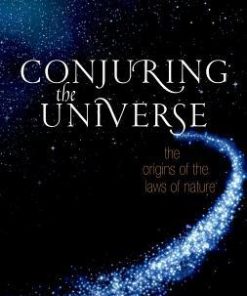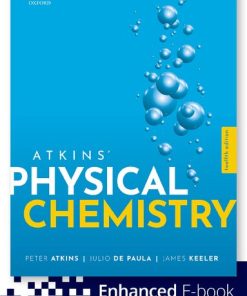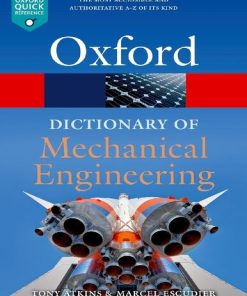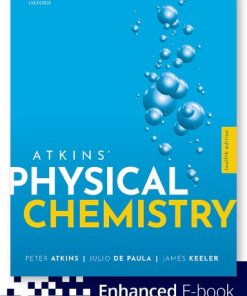(Ebook PDF) Atkins Physical Chemistry 11th Edition by Peter Atkins, Julio de Paula, James Keeler 019258958X 9780192589583 full chapters
$50.00 Original price was: $50.00.$25.00Current price is: $25.00.
Atkins Physical Chemistry 11th Edition by Peter Atkins, Julio de Paula, James Keeler – Ebook PDF Instant Download/DeliveryISBN: 019258958X, 9780192589583
Full dowload Atkins Physical Chemistry 11th Edition after payment.
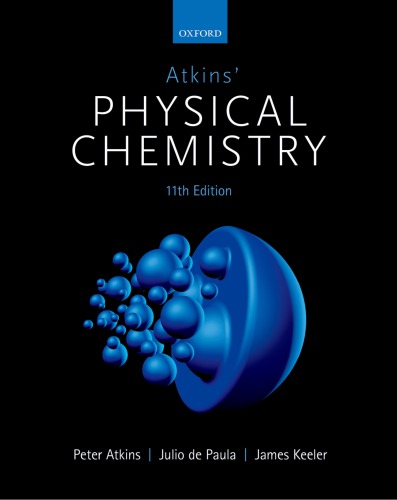
Product details:
ISBN-10 : 019258958X
ISBN-13 : 9780192589583
Author: Peter Atkins, Julio de Paula, James Keeler
Atkins’ Physical Chemistry: Molecular Thermodynamics and Kinetics is designed for use on the second semester of a quantum-first physical chemistry course. Based on the hugely popular Atkins’ Physical Chemistry, this volume approaches molecular thermodynamics with the assumption that students will have studied quantum mechanics in their first semester. The exceptional quality of previous editions has been built upon to make this new edition of Atkins’ Physical Chemistry even more closely suited to the needs of both lecturers and students. Re-organised into discrete ‘topics’, the text is more flexible to teach from and more readable for students.
Atkins Physical Chemistry 11th Table of contents:
1A.1 Variables of state
(a) Pressure
(b) Temperature
1A.2 Equations of state
(a) The empirical basis
(b) Mixtures of gases
Checklist of concepts
Checklist of equations
TOPIC 1B The kinetic model
1B.1 The model
(a) Pressure and molecular speeds
(b) The Maxwell–Boltzmann distribution of speeds
(c) Mean values
1B.2 Collisions
(a) The collision frequency
(b) The mean free path
Checklist of concepts
Checklist of equations
TOPIC 1C Real gases
1C.1 Deviations from perfect behaviour
(a) The compression factor
(b) Virial coefficients
(c) Critical constants
1C.2 The van der Waals equation
(a) Formulation of the equation
(b) The features of the equation
(c) The principle of corresponding states
Checklist of concepts
Checklist of equations
FOCUS 2 The First Law
TOPIC 2A Internal energy
2A.1 Work, heat, and energy
(a) Operational definitions
(b) The molecular interpretation of heat and work
2A.2 The definition of internal energy
2A.3 Expansion work
(a) The general expression for work
(b) Expansion against constant pressure
(c) Reversible expansion
(d) Isothermal, reversible expansion of a perfect gas
(e) The molecular interpretation of reversible expansion
2A.4 Heat transactions
(a) Calorimetry
(b) Heat capacity
Checklist of concepts
Checklist of equations
TOPIC 2B Enthalpy
2B.1 The definition of enthalpy
(a) Enthalpy change and heat transfer
(b) Calorimetry
2B.2 The variation of enthalpy with temperature
(a) Heat capacity at constant pressure
(b) The relation between heat capacities
Checklist of concepts
Checklist of equations
TOPIC 2C Thermochemistry
2C.1 Standard enthalpy changes
(a) Enthalpies of physical change
(b) Enthalpies of chemical change
(c) Hess’s law
2C.2 Standard enthalpies of formation
2C.3 The temperature dependence of reaction enthalpies
2C.4 Experimental techniques
(a) Differential scanning calorimetry
(b) Isothermal titration calorimetry
Checklist of concepts
Checklist of equations
TOPIC 2D State functions
2D.1 Exact and inexact differentials
2D.2 Changes in internal energy
(a) General considerations
(b) Changes in internal energy at constant pressure
2D.3 Changes in enthalpy
2D.4 The Joule–Thomson effect
(a) Observation of the Joule–Thomson effect
(b) Molecular interpretation of the Joule–Thomson effect
Checklist of concepts
Checklist of equations
TOPIC 2E Heat capacity
2E.1 Heat capacity and equipartition
2E.2 Heat capacity and the population of states
Checklist of concepts
Checklist of equations
TOPIC 2F Adiabatic change
2F.1 The change in temperature
2F.2 The change in pressure
2F.3 The molecular basis of adiabatic change
Checklist of concepts
Checklist of equations
FOCUS 3 The Second and Third Laws
TOPIC 3A Entropy and the Second Law
3A.1 The recognition of spontaneous change
3A.2 The direction of spontaneous change
3A.3 The role of entropy
Checklist of concepts
TOPIC 3B The evaluation of entropy
3B.1 The statistical definition of entropy
(a) The Boltzmann formula
(b) The properties of the entropy
3B.2 The entropy in terms of the partition function
3B.3 The thermodynamic definition of entropy
3B.4 The Clausius inequality
3B.5 Entropy changes in the surroundings
3B.6 The equivalence of statistical and thermodynamic entropy
Checklist of concepts
Checklist of equations*
TOPIC 3C Entropy changes accompanying specific processes
3C.1 Expansion
3C.2 Phase transitions
3C.3 Heating
3C.4 Composite processes
Checklist of concepts
Checklist of equations
TOPIC 3D The measurement of entropy
3D.1 The calorimetric measurement of entropy
3D.2 The Third Law
(a) The Nernst heat theorem
(b) Third-Law entropies
(c) The temperature dependence of reaction entropy
Checklist of concepts
Checklist of equations
TOPIC 3E Concentrating on the system
3E.1 The Helmholtz and Gibbs energies
(a) Criteria of spontaneity
(b) Some remarks on the Helmholtz energy
(c) Maximum work
(d) Some remarks on the Gibbs energy
(e) Maximum non-expansion work
3E.2 Standard molar Gibbs energies
(a) Gibbs energies of formation
(b) The Born equation
Checklist of concepts
Checklist of equations
TOPIC 3F Combining the First and Second Laws
3F.1 Properties of the internal energy
(a) The Maxwell relations
(b) The variation of internal energy with volume
3F.2 Properties of the Gibbs energy
(a) General considerations
(b) The variation of the Gibbs energy with temperature
(c) The variation of the Gibbs energy with pressure
Checklist of concepts
Checklist of equations
FOCUS 4 Physical transformations of pure substances
TOPIC 4A Phase diagrams of pure substances
4A.1 The stabilities of phases
(a) The number of phases
(b) Phase transitions
(c) Thermodynamic criteria of phase stability
4A.2 Phase boundaries
(a) Characteristic properties related to phase transitions
(b) The phase rule
4A.3 Three representative phase diagrams
(a) Carbon dioxide
(b) Water
(c) Helium
Checklist of concepts
Checklist of equations
TOPIC 4B Thermodynamic aspects of phase transitions
4B.1 The dependence of stability on the conditions
(a) The temperature dependence of phase stability
(b) The response of melting to applied pressure
(c) The vapour pressure of a liquid subjected to pressure
4B.2 The location of phase boundaries
(a) The slopes of the phase boundaries
(b) The solid–liquid boundary
(c) The liquid–vapour boundary
(d) The solid–vapour boundary
Checklist of concepts
Checklist of equations
FOCUS 5 Simple mixtures
TOPIC 5A The thermodynamic description of mixtures
5A.1 Partial molar quantities
(a) Partial molar volume
(b) Partial molar Gibbs energies
(c) The wider significance of the chemical potential
(d) The Gibbs–Duhem equation
5A.2 The thermodynamics of mixing
(a) The Gibbs energy of mixing of perfect gases
(b) Other thermodynamic mixing functions
5A.3 The chemical potentials of liquids
(a) Ideal solutions
(b) Ideal–dilute solutions
Checklist of concepts
Checklist of equations
TOPIC 5B The properties of solutions
5B.1 Liquid mixtures
(a) Ideal solutions
(b) Excess functions and regular solutions
5B.2 Colligative properties
(a) The common features of colligative properties
(b) The elevation of boiling point
(c) The depression of freezing point
(d) Solubility
(e) Osmosis
Checklist of concepts
Checklist of equations
TOPIC 5C Phase diagrams of binary systems: liquids
5C.1 Vapour pressure diagrams
5C.2 Temperature–composition diagrams
(a) The construction of the diagrams
(b) The interpretation of the diagrams
5C.3 Distillation
(a) Simple and fractional distillation
(b) Azeotropes
(c) Immiscible liquids
5C.4 Liquid–liquid phase diagrams
(a) Phase separation
(b) Critical solution temperatures
(c) The distillation of partially miscible liquids
Checklist of concepts
Checklist of equations
TOPIC 5D Phase diagrams of binary systems: solids
5D.1 Eutectics
5D.2 Reacting systems
5D.3 Incongruent melting
Checklist of concepts
TOPIC 5E Phase diagrams of ternary systems
5E.1 Triangular phase diagrams
5E.2 Ternary systems
(a) Partially miscible liquids
(b) Ternary solids
Checklist of concepts
TOPIC 5F Activities
5F.1 The solvent activity
5F.2 The solute activity
(a) Ideal–dilute solutions
(b) Real solutes
(c) Activities in terms of molalities
5F.3 The activities of regular solutions
5F.4 The activities of ions
(a) Mean activity coefficients
(b) The Debye–Hückel limiting law
(c) Extensions of the limiting law
Checklist of concepts
Checklist of equations
FOCUS 6 Chemical equilibrium
TOPIC 6A The equilibrium constant
6A.1 The Gibbs energy minimum
(a) The reaction Gibbs energy
(b) Exergonic and endergonic reactions
6A.2 The description of equilibrium
(a) Perfect gas equilibria
(b) The general case of a reaction
(c) The relation between equilibrium constants
Checklist of concepts
Checklist of equations
TOPIC 6B The statistical description of equilibrium
6B.1 The relation between K and the partition function
6B.2 Contributions to the equilibrium constant
Checklist of concepts
Checklist of equations
TOPIC 6C The response of equilibria to the conditions
6C.1 The response to pressure
6C.2 The response to temperature
(a) The van ’t Hoff equation
(b) The value of K at different temperatures
Checklist of concepts
Checklist of equations
FOCUS 16 Molecules in motion
TOPIC 16A Transport properties of a perfect gas
16A.1 The phenomenological equations
16A.2 The transport parameters
(a) The diffusion coefficient
(b) Thermal conductivity
(c) Viscosity
(d) Effusion
Checklist of concepts
Checklist of equations
TOPIC 16B Motion in liquids
16B.1 Experimental results
(a) Liquid viscosity
(b) Electrolyte solutions
16B.2 The mobilities of ions
(a) The drift speed
(b) Mobility and conductivity
(c) The Einstein relations
Checklist of concepts
Checklist of equations
FOCUS 16C Diffusion
16C.1 The thermodynamic view
16C.2 The diffusion equation
(a) Simple diffusion
(b) Diffusion with convection
(c) Solutions of the diffusion equation
16C.3 The statistical view
Checklist of concepts
Checklist of equations
FOCUS 17 Chemical kinetics
TOPIC 17A The rates of chemical reactions
17A.1 Monitoring the progress of a reaction
(a) General considerations
(b) Special techniques
17A.2 The rates of reactions
(a) The definition of rate
(b) Rate laws and rate constants
(c) Reaction order
(d) The determination of the rate law
Checklist of concepts
Checklist of equations
TOPIC 17B Integrated rate laws
17B.1 Zeroth-order reactions
17B.2 First-order reactions
17B.3 Second-order reactions
Checklist of concepts
Checklist of equations
TOPIC 17C Reactions approaching equilibrium
17C.1 First-order reactions approaching equilibrium
17C.2 Relaxation methods
Checklist of concepts
Checklist of equations
TOPIC 17D The Arrhenius equation
17D.1 The temperature dependence of reaction rates
17D.2 The interpretation of the Arrhenius parameters
(a) A first look at the energy requirements of reactions
(b) The effect of a catalyst on the activation energy
Checklist of concepts
Checklist of equations
TOPIC 17E Reaction mechanisms
17E.1 Elementary reactions
17E.2 Consecutive elementary reactions
17E.3 The steady-state approximation
17E.4 The rate-determining step
17E.5 Pre-equilibria
17E.6 Kinetic and thermodynamic control of reactions
Checklist of concepts
Checklist of equations
TOPIC 17F Examples of reaction mechanisms
17F.1 Unimolecular reactions
17F.2 Polymerization kinetics
(a) Stepwise polymerization
(b) Chain polymerization
17F.3 Enzyme-catalysed reactions
Checklist of concepts
Checklist of equations
TOPIC 17G Photochemistry
17G.1 Photochemical processes
17G.2 The primary quantum yield
17G.3 Mechanism of decay of excited singlet states
17G.4 Quenching
17G.5 Resonance energy transfer
Checklist of concepts
Checklist of equations
FOCUS 18 Reaction dynamics
TOPIC 18A Collision theory
18A.1 Reactive encounters
(a) Collision rates in gases
(b) The energy requirement
(c) The steric requirement
18A.2 The RRK model
Checklist of concepts
Checklist of equations
TOPIC 18B Diffusion-controlled reactions
18B.1 Reactions in solution
(a) Classes of reaction
(b) Diffusion and reaction
18B.2 The material-balance equation
(a) The formulation of the equation
(b) Solutions of the equation
Checklist of concepts
Checklist of equations
TOPIC 18C Transition-state theory
18C.1 The Eyring equation
(a) The formulation of the equation
(b) The rate of decay of the activated complex
(c) The concentration of the activated complex
(d) The rate constant
18C.2 Thermodynamic aspects
(a) Activation parameters
(b) Reactions between ions
18C.3 The kinetic isotope effect
Checklist of concepts
Checklist of equations
TOPIC 18D The dynamics of molecular collisions
18D.1 Molecular beams
(a) Techniques
(b) Experimental results
18D.2 Reactive collisions
(a) Probes of reactive collisions
(b) State-to-state reaction dynamics
18D.3 Potential energy surfaces
18D.4 Some results from experiments and calculations
(a) The direction of attack and separation
(b) Attractive and repulsive surfaces
(c) Quantum mechanical scattering theory
Checklist of concepts
Checklist of equations
TOPIC 18E Electron transfer in homogeneous systems
18E.1 The rate law
18E.2 The role of electron tunnelling
18E.3 The rate constant
18E.4 Experimental tests of the theory
Checklist of concepts
Checklist of equations
FOCUS 19 Processes at solid surfaces
TOPIC 19A An introduction to solid surfaces
19A.1 Surface growth
19A.2 Physisorption and chemisorption
19A.3 Experimental techniques
(a) Microscopy
(b) Ionization techniques
(c) Diffraction techniques
(d) Determination of the extent and rates of adsorption and desorption
Checklist of concepts
Checklist of equations
TOPIC 19B Adsorption and desorption
19B.1 Adsorption isotherms
(a) The Langmuir isotherm
(b) The isosteric enthalpy of adsorption
(c) The BET isotherm
(d) The Temkin and Freundlich isotherms
19B.2 The rates of adsorption and desorption
(a) The precursor state
(b) Adsorption and desorption at the molecular level
(c) Mobility on surfaces
Checklist of concepts
Checklist of equations
TOPIC 19C Heterogeneous catalysis
19C.1 Mechanisms of heterogeneous catalysis
(a) Unimolecular reactions
(b) The Langmuir–Hinshelwood mechanism
(c) The Eley–Rideal mechanism
19C.2 Catalytic activity at surfaces
Checklist of concepts
Checklist of equations
TOPIC 19D Processes at electrodes
19D.1 The electrode–solution interface
19D.2 The current density at an electrode
(a) The Butler–Volmer equation
(b) Tafel plots
19D.3 Voltammetry
19D.4 Electrolysis
19D.5 Working galvanic cells
Checklist of concepts
Checklist of equations
Resource section
People also search for Atkins Physical Chemistry 11th:
atkins physical chemistry 10e
atkins physical chemistry 12th edition
atkins physical chemistry oup
atkins physical chemistry solutions
atkins physical chemistry 11th edition
You may also like…
Fiction - Literary Fiction
Chemistry - Physical Chemistry
Fiction - Contemporary Fiction
Reference - Thesauri
Chemistry - Physical Chemistry
Business & Economics - Personal Finance





